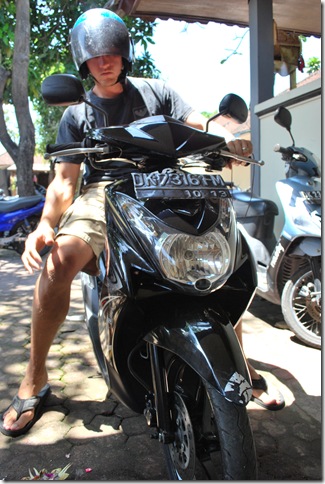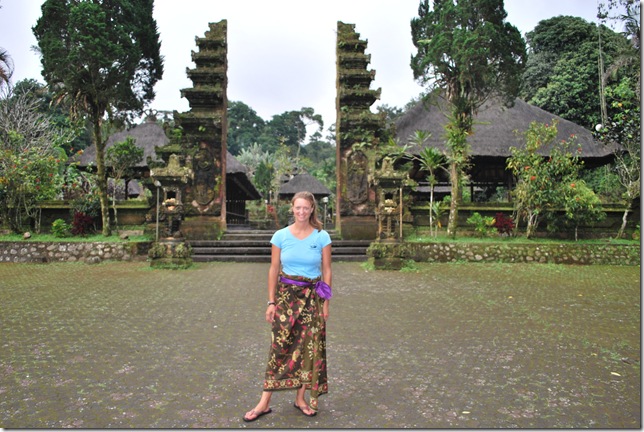Leaving south Bali to enjoy a bit of the itinerary Lauren had planned was exciting, but also a little nerve-wracking. Even though I have a US motorcycle license, I’ve never owned a bike and haven’t driven one much. Luckily bikes in Bali are limited to 250cc. Bike is actually a little bit of a misnomer. Most of the country gets around on scooters, which is what we rented. Ours was an automatic, which definitely made things easier, but Bali traffic was still an adventure. The roads are often narrow, driving is on the left side, and the lanes here taken as helpful suggestions more than rules. Trucks and bikes are constantly using part or most of the other lane to pass or to get around vehicles parked at the side of the road. Traffic is bad enough that people needing to make a turn across traffic often cross when they can and then ride the wrong way down the edge of the road to where they want to turn. Driving the wrong way on the edge is also a common way to get started into busy traffic. Your general responsibility is to watch out for what’s in front of you and assume that those behind you will do the same. Honking is actually a courteous act here that most people use to warn someone that you’re about to overtake them. Intersections are probably the worst, as only a few have working stoplights. The rest are a sort of mad tangle of traffic that’s a little harrowing the first couple of times. Everyone just works their way into the intersection in the direction they want to go, trying not to stop. As you gain practice, you learn how people react and how to smoothly cross in front or behind of a moving car or bike, but my first attempt was a near collision. Luckily a scooter has a pretty short braking distance. The other added complication we had was that the face mask of the helmet I was wearing needed to be down to avoid being pulled over, but it was old, heavily tinted, and so covered with scrapes and scratches that seeing through it was a challenge. If Balinese drivers weren’t so incredibly competent and courteous it would have been a nightmare, but as it was we ended up enjoying it even if we were sore by the end of the day. Lauren sat still behind me and did a great job of reading the occasional road sign preceding an intersection and telling me which way to turn. Without the occasional signs, we would have had a pretty tough time figuring out where we were going. Fueling up was the other funny part of driving. There are gas stations every so often in larger towns where you can buy gas for $0.45/liter, but lots of people just get gas at roadside stands, as anybody with a roadside shop of some sort may be selling gas as well. The shop owner will put a rack of one and two liter glass bottles filled with yellow gasoline out front, with Absolut vodka bottles being the most popular. The premium for the convenience is pretty small – only $0.50/liter, so we used them several times.
 Getting ready to hit the mean streets of Bali
Getting ready to hit the mean streets of Bali
Our first stop was Pura Tanah Lot (Pura means temple). Tanah Lot is a picturesque seaside temple that is actually built on top of a mound of volcanic rock that is separated from the mainland by a short stretch of ocean about 150 feet wide. The tide seemed to be near a low when we were there as several Indonesian men dressed in traditional religious garb were able to cross over to the temple with the water only coming up to their thighs at the deepest point. After checking out the beautiful ground, temples, and views on the cliffs of the mainland, we waded back through row after row of souvenir shops and climbed onto the bike for a ride into the mountains.
After a short stop to down a couple plates of Mie Goreng and cold soft drinks, we climbed up into the cool mountain air through small villages and past hillsides covered with terraced rice paddies until we finally reached Pura Luhur Batukau. Pura Luhur Batukau is billed as a less-visited misty mountain temple and it lived up to its billing. It wasn’t misty when we were there, but it was quiet, cool, and beautiful. To enter a temple here you have to be wearing appropriate clothing, which includes a sarong and sort of satin belt in all cases and a special head wrap as well sometimes. Since most tourists are traveling in Western clothing, the temple staff keep loaner sarongs on hand that they wrapped around us before we entered. While we were having sarongs wrapped around us, we got a good laugh out of the sign saying that the following people were not allowed to enter the temple: (1) Ladies who are pregnant, (2) Ladies whose children have not got their first teeth, (3) Children whose first teeth have not fallen out yet, (4) Ladies during their period, (5), Devotees getting impure due to death, (6) Mad ladies/gentlemen, and (7), Those not properly dressed.
The temple itself was made from stone or concrete with lots of stone carvings, mossy stairways and walls, and traditional courtyards with altars and structures for ceremonies. It was a fairly large complex that seemed to have people living there and was still undergoing expansion. We followed one new concrete path through the forest and down a long stairway until we reached a mountain stream rushing over rounded boulders. It’s only rained once or twice since we’ve been here, but the streams, ditches, rivers, and rice paddies are all full of water running down from the mountains. In typical Asian or at least Balinese fashion, there was a large pile of trash being burned half-heartedly right at the edge of the temple. Bali is a fairly clean place, but there are definitely cases, especially inside or next to otherwise beautiful locations where you see trash piles that would be removed from view in western areas. Even with our loaner sarongs, there were several more sacred parts of the temple where we could only look in because were were tourists or because a ceremony was being performed.
 A properly dressed, only partly mad lady at the entrance to Pura Luhur Batukau
A properly dressed, only partly mad lady at the entrance to Pura Luhur Batukau
The ride to Ubud, our destination for the night, wasn’t quite as smooth. The map in our Lonely Planet book wasn’t really enough to get us there and we went through a fairly large stretch with no useful road signs, especially at one critical point. Bali is such a roadside society, however, that we didn’t even have to get off the bike to ask directions. We just pulled over every 5 or 10 minutes and asked a group of people at a roadside warung which way to Ubud. Like all the Balinese we’ve met, they were immediately friendly and helpful, but it still took us until after nightfall to finally reach Ubud.


